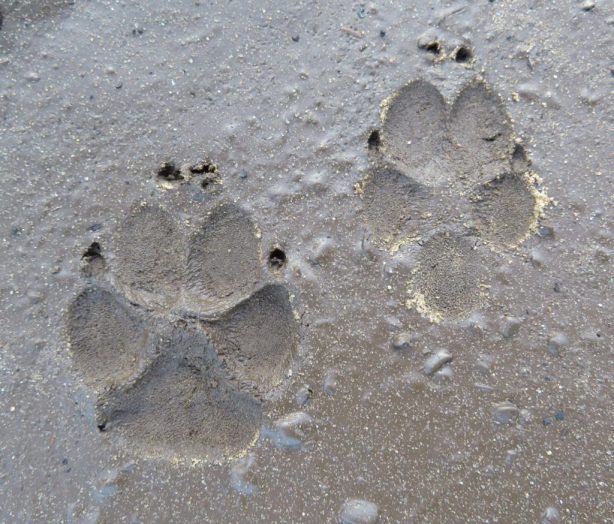Wolf tracks are generally larger than dog tracks, with a distinctive shape and pattern. Wolf tracks have claws that leave a deeper impression on the ground than dog tracks. Wolf Tracks Vs Dog can be difficult to distinguish from each other, especially if the dog is a large breed with a similar paw size to a wolf. However, there are a few key differences that can help you identify which animal left the tracks.
In this article, we’ll explore the difference between wolf tracks vs dog tracks, including their size, shape, and the way they are distributed in the snow. By the end of the article, you’ll be able to confidently identify which animal left tracks in your area.

Credit: www.fws.gov
Background And Introduction To Wolf And Dog Tracks
Wolf tracks and dog tracks can be tricky thing to decipher for the untrained eye. To start, it’s important to understand the difference between wolf and dog tracks. Wolves have larger and more spaced-out tracks due to their wider chests and longer legs.
In comparison, dogs have tracks that are closer together, making them easier to distinguish. When looking for wolf tracks, the terrain is also taken into consideration. Wolves tend to stay on softer ground, while dogs will leave tracks on all surfaces. Knowing these differences can help identify whether tracks belong to a wolf or a dog, and potentially provide insight into the animals’ behavior and movement patterns.
The Anatomy Of Wolf And Dog Tracks
Wolf tracks and dog tracks have distinct differences in their anatomy. Wolves have larger paw pads, long toes, and claws that are more curved and shorter than those of dogs. This enables them to walk in snow or mud without slipping and gives them a better grip during hunting.
Unlike wolves, dogs display different foot positions while walking or running, causing their tracks to vary. They also don’t have thick fur on their paws like wolves do. Knowing these differences can help you identify whether you’re dealing with wild wolves or domestic dogs. By observing their tracks, you can learn a lot about these animals without encountering them in person.
Tracking Behaviors Of Wolves And Dogs
Wolves and dogs have different tracking behaviors, as reported by naturalists and scientists. Wolf tracks are usually straighter in line and narrower than a dog’s prints. Since wolves are more cautious creatures, their tracks bear wider spaces in between. As compared to their wild cousin, domesticated dogs tend to walk in a zigzag pattern and leave a curious scent mark on everything they pass by.
Analyzing and differentiating these tracks can be an essential tool for a tracker to determine whether the animal in question is a wolf or a dog. However, it’s always a good idea to take these tracking behaviors with a grain of salt because many factors can contribute to the differences in their tracks.
Geographical Distribution Of Wolf And Dog Tracks
Wolf tracks and dog tracks are very similar and often hard to distinguish. However, their geographical distribution can help in identifying which is which. Wolves tend to roam in large territories and are rarely seen near human settlements, while dogs are often found near homes and urban areas.
Wolf tracks tend to be larger, with a wider spread between toes, and claw imprints that appear more prominent due to their fur. In contrast, dog tracks are smaller, with a tighter spread between the toes and more visible pad imprints.
In general, wolf tracks are more common in wilderness areas, such as national parks, while dog tracks are more common near populated areas and suburbs. By following these guidelines, you can differentiate between wolf and dog tracks and gain a better understanding of their behavior.
Qualitative Differences In Wolf And Dog Tracks
When trying to distinguish between wolf tracks and dog tracks, there are some qualitative differences to look for. Wolf tracks are larger, rounder, and show a more uniform distribution of weight. Additionally, their toes tend to be more spread out and their nails don’t usually show.
Dog tracks, on the other hand, are more oval-shaped and show uneven weight distribution. Their toes are also closer together and their nails often do show. While the two may look similar at first, paying close attention to little details can help you differentiate between them. So, if you’re out in the wilderness and come across some tracks, make sure to keep these differences in mind to correctly identify them.
Summary Of Differences And Implications
When trying to differentiate between wolf tracks and dog tracks, there are a few key differences to keep in mind. For starters, wolf tracks are typically larger than those made by dogs. In addition, wolves tend to have more of a straight-line gait when they walk, whereas dogs tend to have a more zigzag pattern.
Finally, the spacing between wolf tracks is typically greater than that between dog tracks. These differences have important implications for hunters and wildlife enthusiasts alike, as tracking can be a key component of these activities. By being able to identify the tracks left by different animals, individuals can better understand the behavior and movements of local wildlife.
FAQ For Wolf Tracks Vs Dog Tracks
What Is The Difference Between Wolf And Dog Tracks?
Wolf tracks are typically larger and more spread out than dog tracks. The shape of the paw and the nails also differ.
Can Wolves And Dogs Have Similar Tracks?
Yes, wolves and dogs can have similar tracks. The key is to look at the size and spacing of the tracks, as well as the location where they were found.
How Can You Tell The Direction Of A Wolf Or Dog Track?
The direction of the track can be determined by looking at the leading edge of the paw print. The toes will be pointed in the direction of travel.
What Other Animals Have Similar Tracks To Wolves And Dogs?
Coyotes, foxes, and even some large domesticated animals like cows and horses can have similar tracks to wolves and dogs.
Can Wolves And Dogs Interbreed?
Yes, wolves and dogs can interbreed and produce offspring known as wolf-dog hybrids. These hybrids may have different characteristics and behaviors than purebred wolves or dogs.
Are There Any Safety Concerns With Encountering Wolf Or Dog Tracks?
It is important to be aware of potential dangers when encountering tracks from these animals. In areas where wolves are present, it is recommended to travel in groups and make noise to avoid surprising them. Dogs can also pose a threat if they are aggressive or not properly secured.
Conclusion
After analyzing the differences between wolf tracks and dog tracks, it is evident that the size, shape, and gait are entirely distinctive. Both are powerful creatures and hunters, but their prints leave behind different stories. While wolves are elusive and cautious creatures, domestic dogs are more likely to roam around freely.
It is crucial to identify their paw prints correctly, especially in wild neighborhoods, as it helps to understand animal behavior and prevent any potential conflicts. Overall, if you come across a set of unknown prints, it’s best to seek guidance from a professional or refer to available resources for identification.
Understanding the difference between dog tracks and wolf tracks can be a valuable skill for anyone spending time in the wilderness, offering insight into the mysteries of the animal kingdom and enriching the overall experience.



